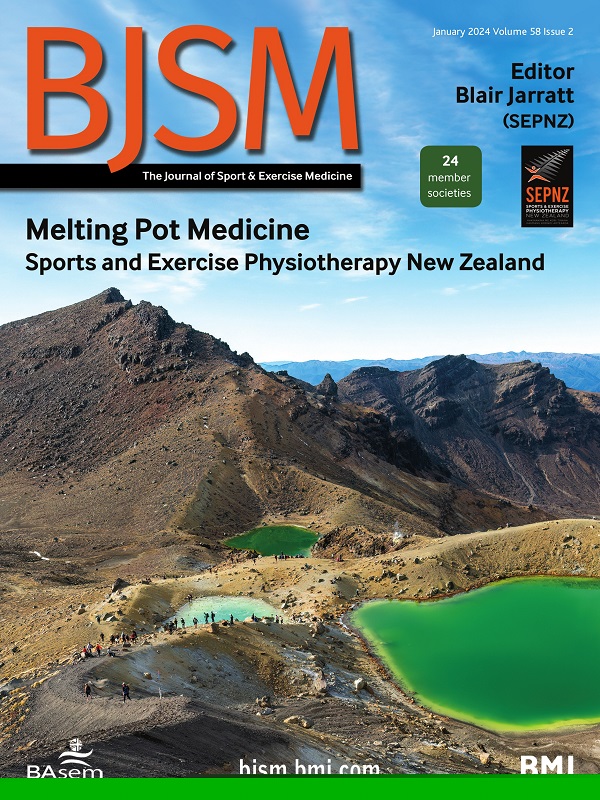Contemporary national and international guidelines on physical activity and sedentary behaviour for people living with chronic conditions, disability and advanced age: a scoping review
IF 11.6
1区 医学
Q1 SPORT SCIENCES
引用次数: 0
Abstract
Objectives Physical activity guidelines inform policy and practice in promoting healthier lifestyles. The WHO advocates for distinct recommendations for each country to address variation in needs, resources and context. Specific regional recommendations for three underactive populations facing unique barriers to movement are lacking—people with chronic conditions, disability and advanced age. We review which countries/regions provide specific physical activity guidelines for these populations to identify deficiencies in meeting WHO recommendations and inform future directions for guideline development. Design Scoping review. Data sources OVID Medline, PubMed, Scopus, Embase, Web of Science, Google Scholar, ProQuest, CINAHL, Google searches, targeted websites. Eligibility criteria Data sources were searched from database inception to September 2023 to identify community-facing physical activity guidelines at the national/international level for these populations. We recorded, summarised and analysed physical activity guideline recommendations extracted from published guideline documents, organised by population and country/region. Results 66 articles were identified, addressing 28 distinct countries/regions, including four international guidelines, published from 2009 to 2023. The WHO guidelines were adopted by 19 countries and the European Union. Across all regions, a lack of specific advice was identified for individuals with chronic conditions (46%), disability (46%) and advanced age (11%). Advice for chronic conditions and disability commonly replicated general adult population advice. Conclusion Many countries/regions do not produce physical activity guidelines specific to populations with chronic conditions and disability. As such, a large proportion of countries/regions failed to meet WHO recommendations, highlighting a lack of customised advice to address unique barriers faced by vulnerable populations. No data are available. Not applicable.关于慢性病患者、残疾人和高龄者体育活动和久坐行为的当代国家和国际指南:范围界定审查
目标 体育活动指南为促进更健康生活方式的政策和实践提供信息。世卫组织主张为每个国家提供不同的建议,以应对需求、资源和环境方面的差异。目前还缺乏针对三种面临独特运动障碍的活动不足人群(慢性病患者、残疾人和高龄者)的具体地区建议。我们审查了哪些国家/地区为这些人群提供了具体的体育锻炼指南,以确定在满足世卫组织建议方面存在的不足,并为今后的指南制定工作指明方向。设计 范围界定审查。数据来源:OVID Medline、PubMed、Scopus、Embase、Web of Science、Google Scholar、ProQuest、CINAHL、Google 搜索、目标网站。资格标准 搜索从数据库开始到 2023 年 9 月的数据源,以确定国家/国际层面针对这些人群的社区体育活动指南。我们记录、总结并分析了从已发布的指南文件中提取的体育活动指南建议,并按人群和国家/地区进行了分类。结果 共找到 66 篇文章,涉及 28 个不同的国家/地区,其中包括 2009 年至 2023 年间出版的 4 份国际指南。19个国家和欧盟采用了世卫组织的指南。在所有地区中,发现缺乏针对慢性病患者(46%)、残疾患者(46%)和高龄患者(11%)的具体建议。针对慢性病患者和残疾人的建议通常与普通成年人的建议相同。结论 许多国家/地区都没有制定专门针对慢性病患者和残疾人的体育锻炼指南。因此,很大一部分国家/地区未能达到世卫组织的建议,这突出表明缺乏针对弱势群体所面临的独特障碍的定制建议。无数据。不适用。
本文章由计算机程序翻译,如有差异,请以英文原文为准。
求助全文
约1分钟内获得全文
求助全文
来源期刊
CiteScore
27.10
自引率
4.90%
发文量
217
审稿时长
3-8 weeks
期刊介绍:
The British Journal of Sports Medicine (BJSM) is a dynamic platform that presents groundbreaking research, thought-provoking reviews, and meaningful discussions on sport and exercise medicine. Our focus encompasses various clinically-relevant aspects such as physiotherapy, physical therapy, and rehabilitation. With an aim to foster innovation, education, and knowledge translation, we strive to bridge the gap between research and practical implementation in the field. Our multi-media approach, including web, print, video, and audio resources, along with our active presence on social media, connects a global community of healthcare professionals dedicated to treating active individuals.

 求助内容:
求助内容: 应助结果提醒方式:
应助结果提醒方式:


